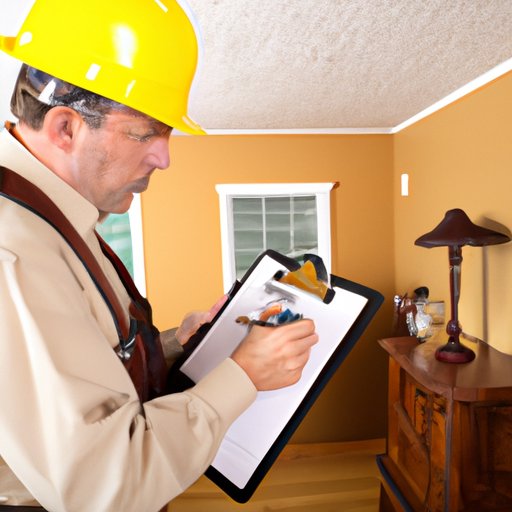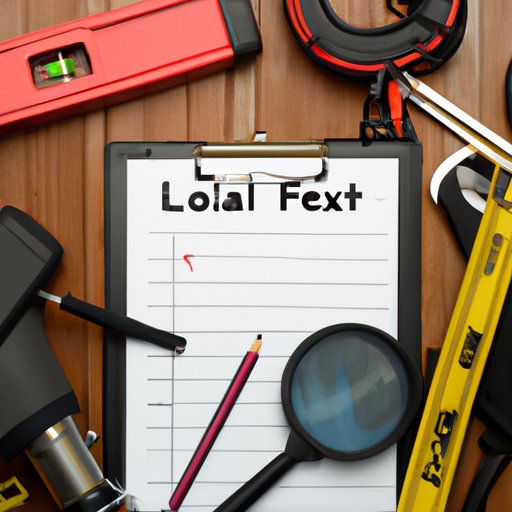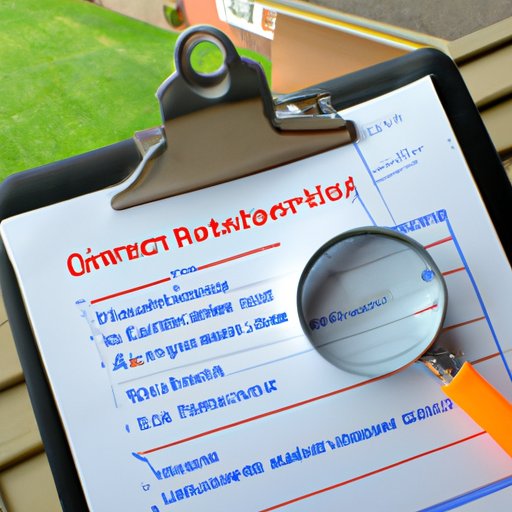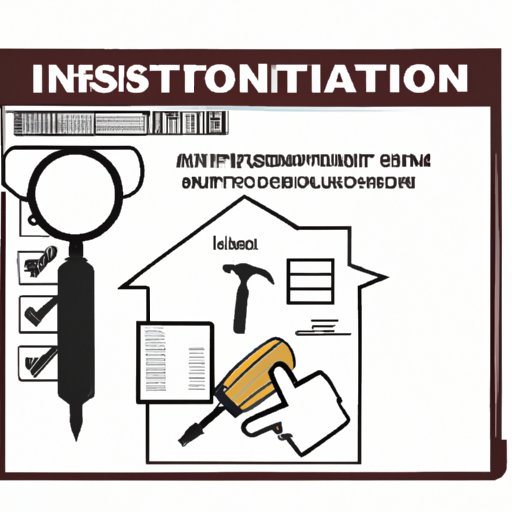Introduction
A home inspector is a professional who evaluates both the interior and exterior of a property for potential issues or hazards. Home inspections can be performed when purchasing a home, or to maintain the safety and integrity of a home over time. Home inspectors must have a keen eye for detail and be able to assess the overall condition of a property.
The job of a home inspector involves researching and evaluating the condition of a home based on various factors. In order to become a certified home inspector, there are certain qualifications and skills that need to be met. Below, we will explore what it takes to become a home inspector and the typical duties involved in this job.
Qualifications and Skills Needed to Become a Home Inspector
In order to become a certified home inspector, there are a few qualifications and skills that need to be met. Education requirements, licensing requirements, experience requirements, and other qualifications and skills are all important components of becoming a certified home inspector.
Education Requirements
Home inspectors typically need to have at least a high school diploma or the equivalent. Although some states may require additional education or training, most home inspectors receive their training through on-the-job experience and self-study.
Licensing Requirements
Each state has its own licensing requirements for home inspectors. Some states require home inspectors to be licensed, while others do not. It is important to research the specific state requirements in order to meet the necessary licensing requirements.
Experience Requirements
Most states require home inspectors to have at least two years of experience in the field before they can be certified. This experience can come from working as an apprentice under a certified home inspector or from completing a home inspection certification program.
Other Qualifications and Skills
In addition to the qualifications and skills mentioned above, home inspectors must also possess strong communication and people skills. They must be able to explain complex concepts in a way that is easy to understand, and they must be able to work with different types of people. Other qualities that are beneficial for home inspectors include problem-solving skills, attention to detail, and the ability to remain calm in stressful situations.
Steps to Becoming a Certified Home Inspector
Once the qualifications and skills needed to become a certified home inspector have been met, there are a few steps that need to be taken in order to obtain certification. These steps include completing education requirements, taking and passing a home inspector examination, and obtaining a state license.
Complete Education Requirements
The first step towards becoming a certified home inspector is to complete the necessary education requirements. Depending on the state, this could include completing a home inspection certification program or taking classes related to home inspection. It is important to research the specific requirements in order to ensure that all educational requirements are met.
Take and Pass Home Inspector Examination
Once the education requirements have been completed, the next step is to take and pass a home inspector examination. This exam is typically administered by the state and covers topics such as building construction, electrical systems, heating and cooling systems, and plumbing systems. It is important to study for this exam in order to pass the test and become a certified home inspector.
Obtain State License
The final step to becoming a certified home inspector is to obtain a state license. This license is usually obtained through the state’s regulatory board and requires passing an exam and paying a fee. Once the license has been obtained, the individual is now a certified home inspector.

Typical Duties of a Home Inspector
Once a person has become a certified home inspector, they can begin performing inspections on homes. Typical duties of a home inspector include inspecting the interior and exterior of homes, reporting findings to clients, and recommending further action if necessary.
Inspecting Interior and Exterior of Homes
The main duty of a home inspector is to inspect the interior and exterior of homes. This includes examining walls, floors, ceilings, windows, doors, appliances, and other components of the home. The inspector must look for any signs of damage or wear and tear in order to identify any potential issues.
Reporting Findings to Clients
Once the inspection is complete, the home inspector must report their findings to the client. This report should include an overview of the condition of the home, any potential issues that were identified, and recommendations for further action if necessary.
Recommending Further Action
If any issues are identified during the inspection, the home inspector may recommend further action to the client. This could include making repairs, replacing parts, or hiring a specialist to evaluate the issue further. It is important for the home inspector to provide clear and concise recommendations in order to ensure the safety and integrity of the home.

Essential Tools and Equipment for Home Inspections
In order to perform a thorough home inspection, there are certain tools and equipment that are essential. These tools and equipment can help the home inspector identify potential issues and ensure the safety and integrity of the home.
Thermal Imaging Cameras
Thermal imaging cameras are used to detect areas of heat loss or air leakage. This is especially helpful when inspecting insulation, windows, and doors. Thermal imaging cameras allow the home inspector to quickly and accurately identify any areas of concern.
Moisture Meters
Moisture meters are used to measure the moisture levels in walls, floors, and other surfaces. This is important for identifying areas of water damage or mold growth. Moisture meters can help the home inspector determine whether or not further action needs to be taken.
Electrical Testers
Electrical testers are used to check the wiring and electrical systems of a home. This is important for ensuring the safety of the home and its occupants. Electrical testers can help the home inspector identify any potential issues that could lead to a fire or electric shock.
Gas Detectors
Gas detectors are used to detect the presence of gas in a home. This is important for detecting carbon monoxide, which can be hazardous to one’s health. Gas detectors can help the home inspector identify any potential problems that could lead to a dangerous situation.
Ladders
Ladders are essential for accessing hard-to-reach areas of a home. This is important for inspecting the roof and other higher areas of the home. Ladders allow the home inspector to get a better view of the property and identify any potential issues.

Preparing Reports for Home Inspections
Once the home inspection is complete, the home inspector must prepare a report for the client. This report should include an overview of the condition of the home, any potential issues that were identified, and recommendations for further action if necessary. The report should be organized and easy to read, so that the client can easily understand the findings.
Gather Information from Homeowner
The first step in preparing a report for a home inspection is to gather information from the homeowner. This can include information about the age of the home, any recent renovations, and any known issues with the property. This information can help the home inspector better understand the condition of the home.
Document Findings from Home Inspection
The next step is to document the findings from the home inspection. This includes noting any potential issues that were identified, as well as any recommendations for further action. It is important to be detailed and accurate when documenting the findings in order to provide the client with a clear understanding of the condition of the home.
Prepare Report for Client
Once the findings have been documented, the home inspector must then prepare a report for the client. This report should include an overview of the condition of the home, any potential issues that were identified, and recommendations for further action if necessary. The report should be organized and easy to read, so that the client can easily understand the findings.
Finding Home Inspection Clients
Once a person has become a certified home inspector, they must then find clients to perform inspections for. There are a few ways to do this, including networking, advertising, referrals, and having an online presence.
Networking
Networking is one of the best ways to find home inspection clients. By attending local events and joining local organizations, home inspectors can make connections with real estate agents, home buyers, and other professionals who may be in need of their services.
Advertising
Another way to find home inspection clients is to advertise. This can be done through print, radio, television, or online. Advertising can be an effective way to reach potential clients, as long as the message is clear and concise.
Referrals
Referrals can also be a great way to find home inspection clients. Home inspectors can ask current clients for referrals, or they can offer incentives for referrals. This can be an effective way to build a client base and increase business.
Online Presence
Finally, having an online presence is another way to find home inspection clients. Home inspectors can create websites and social media accounts to showcase their services and attract potential clients.
Conclusion
Becoming a home inspector is an attractive career option for those looking to use their technical knowledge and people skills. In order to become a certified home inspector, there are certain qualifications and skills that need to be met. These include education requirements, licensing requirements, experience requirements, and other qualifications and skills. Once these qualifications and skills have been met, there are a few steps that need to be taken in order to obtain certification. These steps include completing education requirements, taking and passing a home inspector examination, and obtaining a state license. Once a person has become a certified home inspector, they can begin performing inspections on homes. Typical duties of a home inspector include inspecting the interior and exterior of homes, reporting findings to clients, and recommending further action if necessary. In order to perform a thorough home inspection, there are certain tools and equipment that are essential. Once the home inspection is complete, the home inspector must prepare a report for the client. Finally, finding home inspection clients can be done through networking, advertising, referrals, and having an online presence.
Becoming a home inspector is a rewarding career that allows individuals to use their technical knowledge and skills to help others. With the right qualifications and skills, anyone can become a certified home inspector and start performing home inspections.
(Note: Is this article not meeting your expectations? Do you have knowledge or insights to share? Unlock new opportunities and expand your reach by joining our authors team. Click Registration to join us and share your expertise with our readers.)
